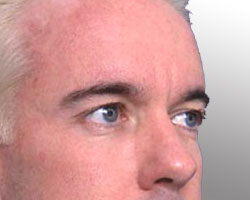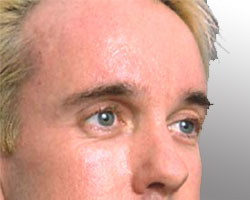Forehead Lift
Are you thinking of a forehead lift?
A forehead lift is a surgical procedure that gives people a younger and a fresher look on the area above the eyes. The operation involves lifting eyebrows that have begun to sag and to even out the forehead wrinkles that can make people look angry, sad or tired. The forehead becomes smoother and the general look of the face is more relaxed. The information on this page might give you a basic understanding on the surgery if you are thinking of a forehead lift. When it can help, where it takes place and what result to expect. They probably do not answer all your questions, as there are many things that are individual regarding plastic surgeries. Ask the doctor if you need to know more.
Is a forehead lift the right solution for you?
A forehead lift is a plastic surgery usually performed on people at age between forty and sixty to reduce visible age symptoms. The operation can however be useful for people in all ages that have had wrinkles on the forehead or between the eyes because of stress and tired muscles. Individuals with family symptoms, for example saggy and heavy eyebrows and worry wrinkles between the eyes can gain a livelier appearance with a forehead lift. This operation if often performed parallel to a face lift. Also, eye lid surgery (blepharoplasty) is also often performed parallel to a forehead lift, especially if a patient has a dewlap above the eyes. It is sometimes the case that people who think they need eyelid surgery find out that a forehead lift is more suitable for them. Keep in mind that a forehead lift can improve your look and confidence but it does not change your appearance completely nor does it lead to people changing the way they approach you. If you take the decision to undergo plastic surgery you need to review your expectations and discuss them with your doctor.


Risk factors
Risks are rare and usually minor when it comes to a forehead lift with an experienced plastic surgeon. Still, the patient needs to beware of a few risk factors. Occasionally, the nerves the control the movements of the eyebrows get damaged in the operation, on one side or both, so that the quality to lift the eyebrows or wrinkle the forehead is reduced or disappears. It is also possible that some loss of hair growth happens on rare occasions. It is common for patients to lose sensation near the scar or on both sides of it. This usually passes off in a relatively short time but a few patients might lose this sensation permanently. Infections and bleeding is very rare after a forehead lift but can happen. You can reduce the risk by following your doctor's prescriptions thoroughly both before and after surgery
To decide for a forehead lift surgery
In order to realise the effects of the surgery on your appearance you should stand in front of a mirror and lay the palms of your hands flat just above your temple and the eye brows. Pull up the skin carefully upwards to lift the eyebrows and the forehead. When you do this, you can see approximately what a forehead lift can do for you.
The doctor examines your face, the skin and the bone structure underneath it. During your first interview the doctor will discuss with you your expectations and he will ask you questions regarding your physical condition, medicine, etc. that could affect the outcome of the surgery, for example if your blood pressure is too high, if you have an untreated embolism or if your scar tissue formation is incomplete. You should tell your doctor if you had a beautifying surgery before, whether you smoke or whether you take any medicine on a regular basis, for example medicine with blood thinning effects.
If you decide to have a forehead lift, the doctor will explain to you the procedure, the anaesthesia, the facilities, the risk and the cost not to forget your expectations and possible worries regarding the surgery. Top of page.
Preparation for surgery
The doctor gives you advice on how to prepare for the operation regarding food and drink, smoking and medicine. It usually applies that you need to fasten from midnight the night before the operation. Stop smoking at least four weeks before the operation. If you follow these instructions thoroughly°° you reduce your risk factors and the recovery will be quicker than otherwise. If you have very short hair it might be better for you to let it grow that it can hide the scar after the incision. Arrange for someone to pick you up at the health clinic and be there for you for at least one or two days after the operation. Efst á síðu.
The operation room, anaesthesia and the surgery
Before the surgery is performed the patient has an intravenous sedative and is then anaesthetized. The hair is put up in elastics on each side of the incision line before the surgery. There is usually no need to cut the shave the scalp but it might be necessary to cut the hair closest to the incision. I most cases the incision is laid down from ear to ear, that is it begins just above the ear and then follows a line similar to headsets over to the other ear. The scar can usually not be seen whereas it is situated in the scalp itself. Those who have very high forehead or a receding hairline will have their incision just in front of the scalp so that the forehead does not get higher than it already is. The patient can change their hairstyle to cover the scar, for example by using a hair top. Bold men or those with very thin hair usually have their incisions on the top of their head, according to the natural shape of the skull.
After the incisions have been made, the skin on the forehead is lifted carefully so that it is possible to remove the tissue underneath and change or adjust the muscles in the forehead. Then the eyebrows are lifted and excessive skin is cut off to provide for a younger and a fresher look. Finally the incisions are stitched up and bandages put on. You can rinse your hair in two days after the surgery. Top of page
After the surgery
Most patients feel numbness or temporary inconvenience around the incisions but mild aches can be treated with pain killers. Patients sometimes suffer from headaches might need more effective medicine to improve recovery. For some people it is effective to hold up the head higher than the body for two to three days after the surgery to diminish swelling. The swelling can come down to the cheeks and the eyes but is should disappear in two to three weeks. When the nerves begin to recover the numbness in the scalp can turn into an itch that can last up to six months. The stitches are usually removed in two steps, five to seven days after the surgery. Some loss of hair can occur around the incision and the hair can be somewhat thinner for a while. In a few weeks or months the hair should be back to normal. Permanent hair loss is very rare. Top of page
Full recovery
You will feel better in about three days but you are advised to take it easy the first week after the surgery. It is safe to have a shower and wash the hair two days after the surgery but be careful around the wound. Most patients have returned to work within a week or ten days. Strenuous exercise should be avoided for a few weeks, for example running, bending forward, difficult household task, sex or other things that could raise your blood pressure. Patients should avoid heat or sunshine for the next months after the surgery. The most visible symptoms after the incision should disappear in about three weeks. Lesser bruise or swelling can be hidden with a makeup. Just after the operation you will probably feel more tired than usual but you will feel increased energy when the new look starts to kick in and your health improves. Top of page
The new look
Most patients are content with the result of the forehead lift. Sometimes they do not appreciate how a wrinkled forehead makes them look younger and less worried and how their general look improves. Even though a forehead lift does not stop the progression of time it can reduce the visible symptoms of aging for years to come